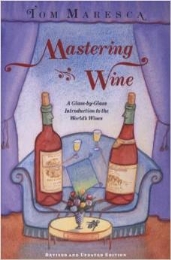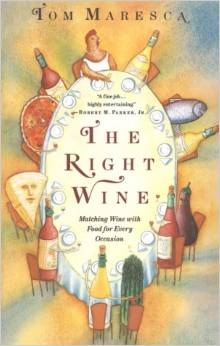Diane and I are in the process of bringing home the wines that we have stored off-premises for many years. Just having those goodies nearby has prompted me to – shall we say? — look into them, just to see how they’re doing. So far I have been very happy with the results, so here is a kind of interim report on some of the cellar gems whose corks I’ve pulled recently.
.
Luis Pato Quinto do Moinho 2000
.
.
This is a big, big, big wine! Coffee and currants in the aroma were followed by a rush of semi-soft tannins, black currants, berries, and coffee in the mouth. This single-vineyard Baga feels strikingly larger than its modest 12.5% alcohol would indicate. It’s not hot, but mouth-filling and complex, with a lingering coffee/berry finish – in all, a fine, distinctive wine. It went nicely with a risotto of mushrooms, onions, and Spanish chorizo. The cheese course (Pont l’Eveque and Taleggio) brought up all the wine’s sweet fruit.
Vinified from 100% Baga, an indigenous Portuguese grape, and by one of Portugal’s most renowned winemakers, Luis Pato, it seems to have decades yet in front of it. It strikes me as a great wine in all respects, and markedly different in flavor and accent from Spanish, French, or Italian reds: A strong reminder that I must pay more attention to the wines of Portugal.
.
Col d’Orcia Brunello di Montalcino 2006
.
.
As its name implies, Col d’Orcia sits above the Orcia river, in the extreme southwest corner of the Brunello zone. Its 108 hectares of Sangiovese grosso vines consistently yield one of the best Brunellos of the zone, and this one is no exception. It opened with a rich, vinous, cherry-and-earth nose. On the palate it felt big but soft and tasted of black cherry and tar/tobacco, very deep, with a long finish.
This was an excellent wine, very elegant and balanced, as I’ve come to expect from Col d’Orcia. Its fruit was very rich, almost sweet, combining youthful zest with mature depth. Clearly, a wine to enjoy now and for at least the next ten years: Col d’Orcia just seems to go from strength to strength.
.
Sartori Amarone Corte Bra 2004
.
.
Sartori is a third-generation, family-run winery. Its vineyards are in the heart of the Valpolicella zone, and it handles its vines and grapes in a very traditional manner, resulting in Amarones of great character. This one had an almost-Port-like aroma, big with dried fruits. On the palate, it showed soft and velvety, with fully mature and deep fruit flavors. Concentrated black plums predominated, but different layers showed as it opened in the glass or followed a bite of braised duck or vegetable.
True to Amarone style, this was a huge wine, but well-mannered. As it grew and grew in the glass, I found my wine-speak failing me, and all I could think of to say was “What an incredibly winey wine!” When I lose language, you know the wine is amazing.
.
Three great red wines. Now, I realize that August isn’t the ideal time to be writing about serious red wines. But as a concession to the season, I also opened some older bottles of white wine – including one you probably wouldn’t expect.
.
Fontana Candida Frascati Luna Mater 2012
.
.
This was lovely, fully live and fully mature: no primary fruit flavors, but plenty of mature ones — guava, spiced pear, mace, and more. It showed wonderful balance and smooth, mouth-filling flavor, plus a long, sapid, refreshingly acid finish of dried white fruits. As fine a mature white wine as one can imagine, it was delightful with olive bread and big cheeses.
Who knew Frascati was capable of this? I at least should have: I’ve been preaching the gospel of the quality and longevity of Italian white wines for a long time, and I should have realized that the grapes that go into Frascati – Trebbiano Toscano and Malvasia – undistinguished as those may seem to be, are just as capable of yielding top-flight, long-lived wines as any other Italian white grape, when they are selected and treated with respect and care. A bottle like this one is certainly proof of that.
.
Paumanok Minimalist Chenin Blanc 2014
.
.
I had wrongly listed this wine in my storage sheets as Paumanok’s basic Chenin Blanc 2019, and so, without looking very closely at the bottle, I chilled it and served it with a very simple meal – which it totally blew away. I hope this was just my ordinary befuddlement and not the first sign of senile dementia.
On behalf of the soundness of my senses, I can say that from the first sip I realized this was a special wine – as, at last, an attentive look at the label quickly confirmed. Paumanok Vineyard’s Minimalist wines are vinified from specially selected lots of grapes, often left a little longer on the vines to attain complete ripeness, and then handled minimally in the cellar so that in the bottle they show the grapes and the soil, not the winemaking.
This bottle was maturing beautifully but still quite fresh, with classic Chenin fruit, dry and chalky yet still floral and hinting variously of apple and especially pear: a wonderful wine from Long Island’s North Fork, which perfectly captures the essence of Chenin Blanc. I’d guess it has years of life still before it. In my opinion, with Chenin Blanc, Paumanok does as well as or better than any American winery on either coast. My erroneous listing betrayed me into an unexpected treat. Would that all my mistakes were so lucky.
.
Benanti Etna Bianco Superiore Pietra Marina 2012
.
.
Benanti is a leader in fine Etna wines. The family firm has been totally committed to quality production on Etna for decades now, from long before Etna became celebrated and fashionable. For many of those years, Benanti’s winemaker was the now universally acclaimed Salvo Foti, and he consistently drew the best from the fine properties that Benanti farmed.
Pietra Marina is one of the most important of those. 800 meters up the eastern slope of Etna, planted entirely to Carricante, the indigenous white grape of the volcanic zone, Pietra Marina’s grapes yield juice of delicious concentration, capable of long life and steady maturation. This exemplary bottle was just plain lovely, mineral and fresh and bracing. It started with a beautiful aroma of dried pears and little hints of apricot. That followed through on the palate with some apple joining the fruit chorus, all buttressed by a tingling minerality, and all held in a wonderful balance of fruit and acid. For all the richness of its flavors, it was a restrained wine, not at all aggressive or assertive, but completely welcoming. I kept thinking as I drank it that I would really like to taste it alongside a grilled fresh porcini cap – hard to find here in New York, but maybe worth the flight to Sicily for.
Just for the record: Pietra Marina is capable of much greater aging than this 11-year-old. I’ve been lucky enough, during several visits to Benanti, to taste 20- and 23-year-olds that were totally fresh and live and as lovely as this bottle. Great terroir, great variety, great care, and great talent: it all makes a very great wine.
















